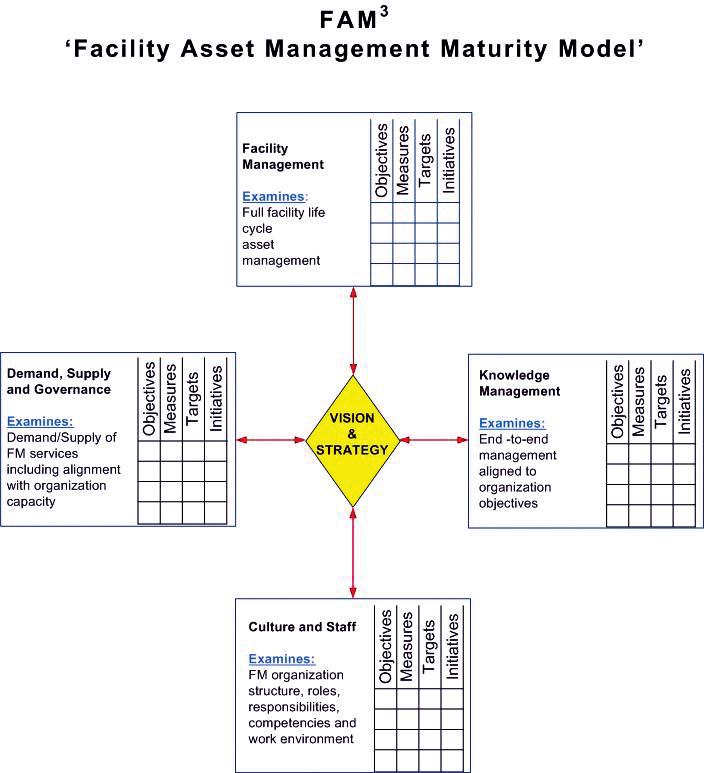
3 minute read
FAM3: Facility Asset Management Maturity Model
AUDIO VISUAL INSTALLATION SUPPLIES.
Cables – Ceiling Mounts • Flat Panel Mounts • Patch Panels • Wall Plates Speakers – PA Systems – Projectors www.AVSolutions.ca 604.599.0333
Facility managers have seen an exponential increase in demand for accountability; they operate under a level of scrutiny never before seen as stakeholders are dealing with stringent economic conditions. At the same time, emerging technology and new service delivery techniques have provided innovative opportunities to evolve and grow to meet these challenges. The key for facility managers is to understand the relative ‘maturity’ of their facility asset management delivery systems/processes and be able to compare them against global best practices.
Maturity is not measured in years but is measured in terms of service delivery/process value. Measurement tools are needed to help analyze, understand, and take action in a planned, valued and strategic manner. The breadth and scope of the information that is available to us needs to be defined and managed; not measuring (or doing nothing) is not an option, and will result in system/process failure.
The level of maturity for every organization is different, and it is important to step away from day-to-day operations and assess where your own organization is. The FAME team has developed a ‘FM Balanced Scorecard’ that can assist facility managers in understanding their facility’s maturity and plan their journey toward a best-practice, bestmanaged organization. The accompanying chart conceptually illustrates the FAME process: there are four silos of knowledge that must be evident in every FM organization, and each of these silos must contribute to the overall FM organization ‘maturity’.
By going through a strategic planning process utilizing KPIs (key performance indicators) and KRAs (key result
areas), the objectives, measures, targets, and initiatives can be defined, measured and managed.
Facility Management Silo: Examines facility condition, preventative maintenance, maintenance management, opera tions management, asset management, and energy management. Maturity ranges from reactive dedicated resources reliant on hands-on knowledge to cost-effective, pooled and shared technology resources leveraging knowledge-based full-facility life cycle management.
Knowledge Management Silo: Examines FM resources used to plan, manage, and improve delivery of facility services. Maturity ranges from projectbased tools and information to strategic, integrated tools, processes and information collection for end-to-end management aligned to organization goals and objectives.
Culture and Staff Silo: Examines FM organizational structure, roles, responsibilities, competencies and work environments. Maturity ranges from a handyman generalist environment to a more proactive service oriented, FM business-centric environment.
Demand, Supply and Facility Gover nance Silo: Examines corporate de mand for facility management services and the supply of those services. Maturity ranges from facility management as a cost centre to a facility management governance model that provides real-time alignment of facilities, to corporate demand with funding aligned to total cost of ownership.
Across the four domains, the FAME team gathers information that can be analyzed and plotted to demonstrate the relative maturity level of a FM organization. Five stages are utilized after the data has been analyzed: • Stage One: Individualized/ compartmentalized • Stage Two: Standardized • Stage Three: Optimized • Stage Four: Automated/ technology-enhanced • Stage Five: Full organizational alignment
With this new understanding, a facility manager would have a plan that guides them through a maturity journey. Leveraging the benefit of prior experience, a common language and shared vision, the facility manager has a measurable management framework for tactical and strategic initiatives. This will allow them to move from an environment where commitments are missed and costs are out of control to one where services are delivered within a mutually agreed framework with users; where agile processes propel improved quality, and where organization alignment engages the highest level of staff commitment and morale.
Prepared by: Steve Cripps, President/Managing Principal Ed Deviat, Senior Solutions Architect Phone: 1-403-457-3263 www.fameassets.com












